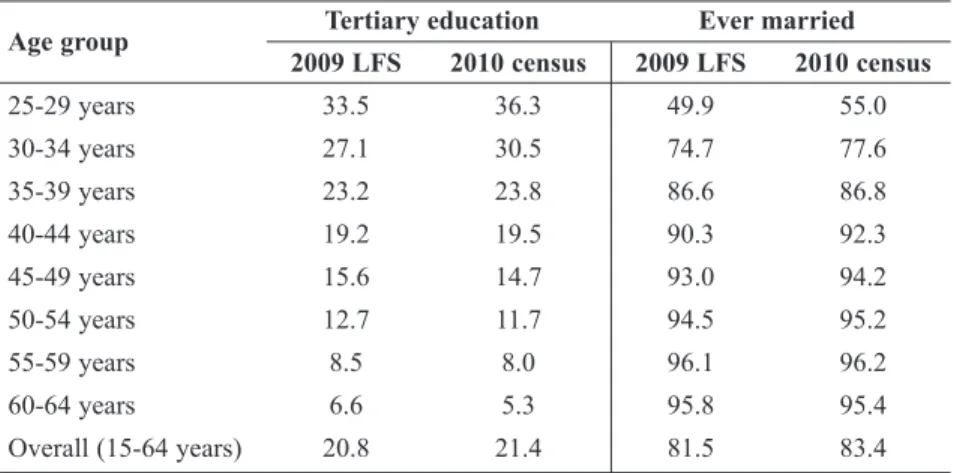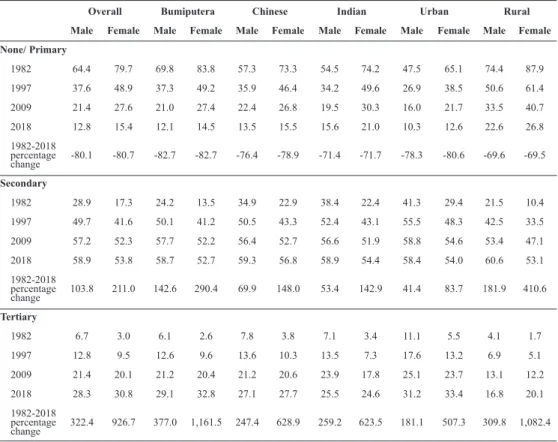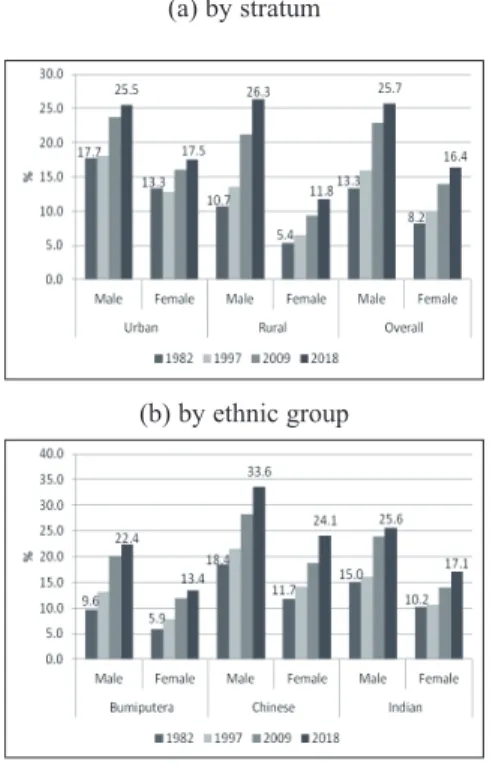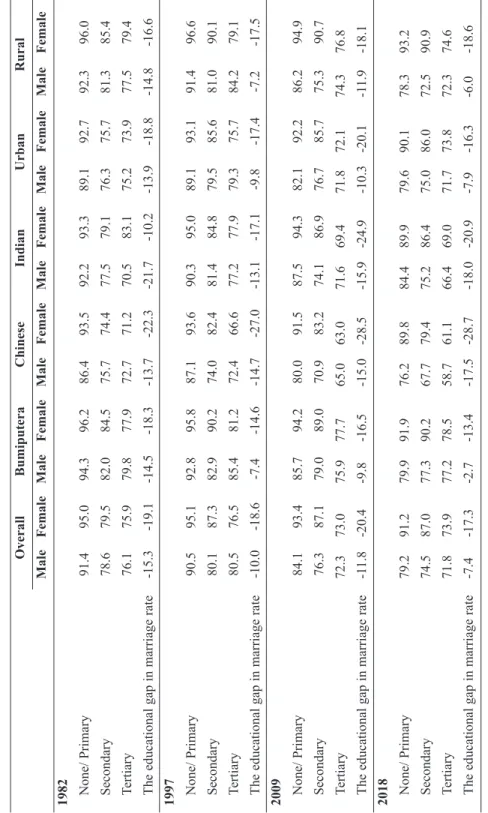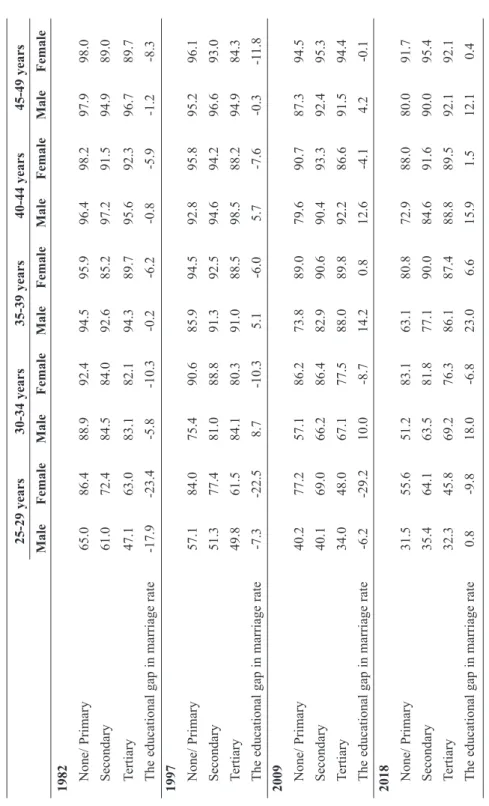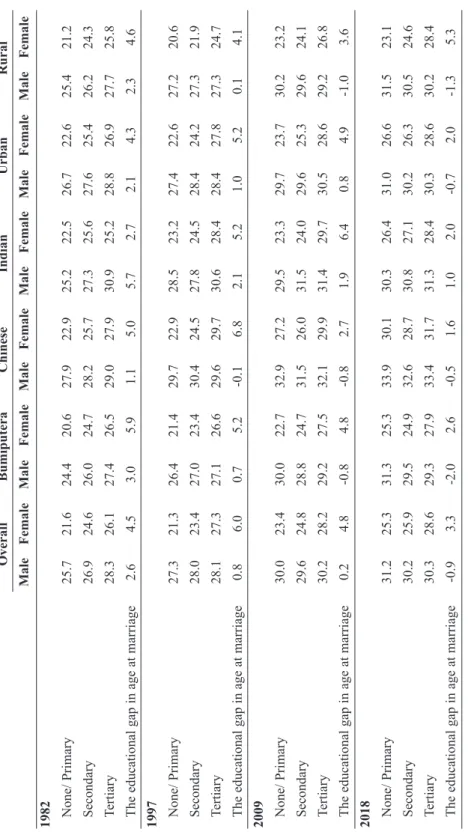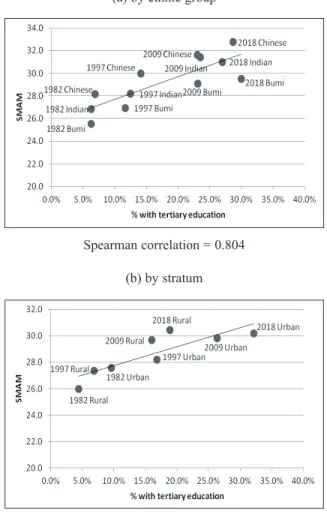A detailed explanation of the sampling design is available in the main survey report, which can be downloaded from the DOSM portal. The analysis began with an examination of changing educational levels and marital status over the past forty years. Since no information on age at marriage was collected in the LFS, the SMAM was calculated to indicate an increase in the number of postponed marriages over the period 1982-2018.
This period measurement of age at marriage is subject to several shortcomings (Hajnal, 1953), such as biases arising from the use of five-year age groups in the calculation, different age distributions. Nevertheless, considering that over 90% of men and women aged 15-19 were never married in the selected waves of the LFS, the inclusion of this age group in the calculation of SMAM at the tertiary level will only have a little effect on estimated SMAM. The LFS showed that the proportion with youth education and higher education had increased faster in rural areas compared to urban areas, especially among women.
The gender gap in the marriage rate was smallest at tertiary level and did not change much over time. However, the gender gap in the marriage rate at primary and secondary education levels has widened over time due to the faster decline in the marriage rate among men. An increase in the marriage rate was observed among women with secondary education for all ethnic groups, and Bumiputera women with tertiary education.
Between 1982 and 2018, rural residents with little or no primary education saw a greater decline in marriage rates than their urban counterparts, especially among men. The gender gap in the proportion ever married was relatively larger among those with lower education, but the urban-rural gap was negligible at the tertiary level in recent years. Between 1982 and 2018, the decline in marriage rates was faster among those with less education than those with more education, across all age groups.
On the other hand, the marriage rate among secondary school-educated women aged 35 and over and tertiary-educated women aged 45-49 has increased. The average age at marriage of women in cities was always higher than in rural areas, especially at lower levels of education. In 1982, the proportion with tertiary education was about the same for all ethnic groups, but there was considerable variation in age at marriage, with the Chinese reporting the latest and the Bumiputera the earliest, for both men and women.
Urban residents had higher education and married later than those living in rural areas, resulting in a strong positive correlation between the two variables. There was a slight deviation in the lower marriage age among urban men than among rural men in 2018, given their educational difference. Some of this could be attributed to the fact that the majority of the population is in the federal administrative center.
Some of this could be attributed to the fact that the majority of the population in the Federal Administrative Center consists of Bumiputera, who are more likely to marry than the non-Bumiputera, as mentioned above.

Multivariate analysis
The control variables in model 1 include ethnic group and stratum, while age was added in model 2. The likelihood ratio test of overall significance shows that all the independent variables were significant in explaining the dependent variable in each of the logistic regression models (p < 0.001). The overall percentage of correct prediction was higher for Model 2 compared to Model 1, especially for males.
The first model shows a negative educational gradient in the marriage rate (percent ever married), as indicated by odds ratios less than 1 and negative marginal effects. In the second model, adjusting for age would have reduced the negative educational gradient in the marriage rate and even turned into a positive effect in later years, as indicated by odds ratios greater than 1 and positive marginal effects. In 2018, men and women with secondary and tertiary education were more likely to be married than those with primary or no schooling, after controlling for ethnicity, class and age in the model.
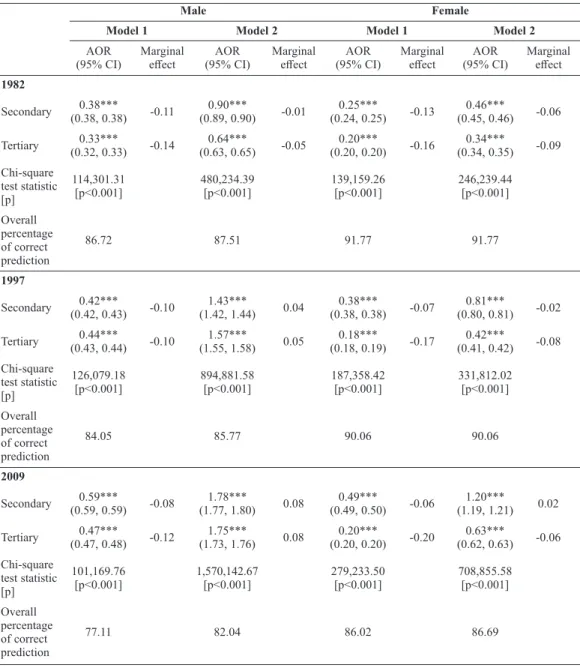
Discussion
Studies have found that more education resulted in greater female labor force participation (England et al., 2012; Tienda et al., 1992) and improved women's employment status (Li and Cheng, 2019). The 2014 Malaysian Population and Family Survey found that childcare was the main reason for women to stop working (see Abdullah, et al., 2021 in this issue). This study found that better-educated women were just as likely to marry as less-educated women, albeit at a later age.
Better-educated women tend to marry later due to extended years of schooling and the tendency not to marry while in school (Blossfeld and Huinink, 1991; Sabbah-Karkaby and Stier, 2017). Women also tend to spend their first decade of adulthood "enjoying" the experience of working before marriage (Quah, 2005). The higher opportunity cost of marriage among more educated women did not lead to fewer marriages, but it was positively associated with late marriage.
The high marriage rate of tertiary-educated women and the low rate of participation in the workplace (despite significant increases in recent years) suggest that marriage and family institutions remain the foundation of social institutions. Women's education is directly related to delaying marriage for all ethnic groups, but it should be noted that less educated Chinese women experienced the largest increase in SMAM over time. Tey (2009) also found that tertiary education among Malays between 1970 and 2000 only resulted in delayed marriage rather than nonmarriage, and this study reaffirms the continuity of this pattern in the 21st century.
Nevertheless, it is important to note that the weakening or reversal of the negative marital education gradient occurs after further adjustment for age in this study. Previous research in countries such as the United States has shown that better-educated individuals are more likely to marry later in life than their less-educated counterparts (Cherlin, 2010; Goldstein and Kenney, 2001; Schoen and Cheng, 2006; Thornton et al.) . al., 2007). Highly educated women were more likely to postpone marriage than less educated women for the younger cohorts, but this is not the case for the older cohorts (Kroeger et al., 2015).
These findings indicate that the educational effect on marriage may deviate from group to group. As educational attainment increases, younger cohorts tend to be more educated than older cohorts. Crossing the educational gradient suggests that the conventional education-marriage link needs to be reevaluated.
Limitations
In this analysis, younger individuals were over-represented as the LFS focused on prime working-age individuals (79.8% aged under 50 in the 2018 LFS).
Conclusion
The scenario was reversed in recent years, where the specialization of gender roles has become lower and the attainment of higher education was normative for women. Since the adoption of the New Population Policy in 1984, the direction of the program has shifted from family planning to family development. The importance of marriage and family formation as well as family values should be inculcated in schools and through social media campaigns in order to preserve and strengthen the institution of marriage in Malaysia.
This work was supported by the National Population and Family Development Board of Malaysia (Grant No: GA025-2021). The changing determinants of women's first trade union formation in industrialized countries: USA, Canada, Italy and Sweden. Factors influencing changes in mean age at first marriage and proportions of never-marries in low-fertility countries in East and Southeast Asia.
Persistent escape from marriage and parenthood among overseas Chinese in East and Southeast Asia: Dimensions and implications. Associations between education and age at marriage among Palestinian women in Israel: Changes over time.
